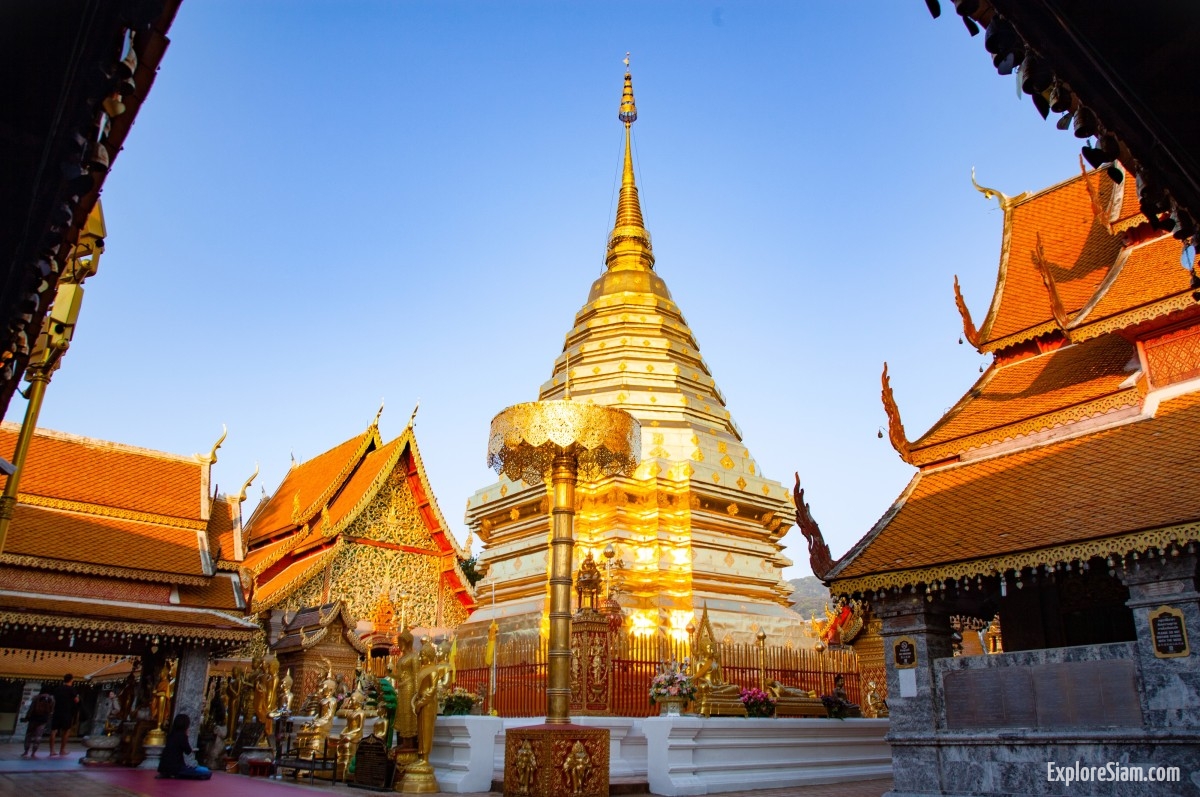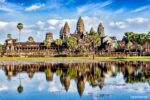Perched majestically on the Doi Suthep mountain, overlooking the vibrant city of Chiang Mai, lies Wat Phra That Doi Suthep, a revered Buddhist temple whose art and architecture tell the rich history of Buddhism. This temple is not just a place of worship; it is a living museum that narrates centuries of religious and cultural evolution.
Historical Significance
The origins of Wat Phra That Doi Suthep date back to 1383 when King Keu Naone commissioned its construction. According to legend, a monk named Sumanathera had a dream in which he was instructed to find a relic. He discovered a bone believed to be from the Buddha himself. This relic was placed on a white elephant, which climbed Doi Suthep, trumpeted three times, and died. The king took this as a sign and built the temple at the site.
Architectural Marvels
The temple complex is a stunning example of northern Thai architecture, blending Lanna, Mon, and Burmese influences. The journey to the temple begins with a climb up 306 steps, flanked by mythical Naga serpents. These serpents, guardians of the temple, are intricately designed and set the tone for the art and symbolism that await within.
At the heart of the temple is the golden chedi, a dazzling structure that enshrines the relic. This chedi, covered in gold leaf, glistens under the sunlight and is surrounded by smaller, intricately decorated stupas, shrines, and statues. The base of the chedi features scenes from the life of the Buddha, depicting his birth, enlightenment, first sermon, and death. Each panel is a testament to the artistry and devotion of the craftsmen.
Murals and Paintings
One of the most striking features of Wat Phra That Doi Suthep is its collection of murals and paintings. These artworks adorn the walls of the viharn (assembly hall) and other buildings within the complex. They depict various episodes from the Jataka tales – stories of the previous lives of the Buddha. Each mural is a visual narrative, illustrating moral lessons and the journey towards enlightenment.
The murals are painted in vibrant colors, with meticulous attention to detail. The artists employed traditional techniques, using natural pigments and intricate brushwork. The scenes are framed by ornate borders, often featuring floral patterns and mythical creatures, which add to the richness of the visual storytelling.
Sculptures and Statuary
Sculptures play a significant role in the artistic narrative of Wat Phra That Doi Suthep. The temple grounds are home to numerous statues of the Buddha in various poses, each symbolizing different aspects of his teachings. One of the most revered statues is the Emerald Buddha, a small yet highly significant figure believed to protect the temple and its visitors.
In addition to the Buddha statues, the temple features sculptures of various deities and mythical beings from Buddhist cosmology. These include the yakshas (guardian giants) who stand watch at the entrance, and the kinnara (half-human, half-bird creatures) who are believed to be celestial musicians. Each sculpture is imbued with symbolism, conveying aspects of Buddhist philosophy and mythology.
Symbolism and Spirituality
The art of Wat Phra That Doi Suthep is not merely decorative; it is deeply symbolic. Every element, from the layout of the temple to the smallest detail in a painting, is infused with meaning. The golden chedi, for example, symbolizes the radiance of enlightenment, while the serpents represent the path of spiritual ascent.
The temple’s architecture follows the mandala design, a geometric pattern that represents the universe in Buddhist cosmology. This design is intended to guide the visitor on a spiritual journey, from the earthly realm to the divine. As one moves through the temple, from the base of the steps to the top of the chedi, there is a sense of ascending towards higher spiritual states.
Preservation and Restoration
Over the centuries, Wat Phra That Doi Suthep has undergone numerous restorations to preserve its art and architecture. The harsh mountain climate and the passage of time have taken their toll on the temple’s structures and artworks. However, the dedication of the local community and the efforts of conservationists have ensured that the temple remains a vibrant cultural and spiritual center.
Recent restoration projects have focused on maintaining the integrity of the original artworks while using modern techniques to protect them from further deterioration. These efforts have included cleaning and repairing murals, stabilizing the chedi, and reinforcing the naga stairway. The goal is to preserve the temple not just as a historical monument, but as a living, breathing space for worship and reflection.
Cultural Festivals and Rituals
Wat Phra That Doi Suthep is also a focal point for numerous cultural festivals and rituals, which add another layer to its rich narrative. One of the most important events is the annual Visakha Bucha Day, which celebrates the birth, enlightenment, and death of the Buddha. During this festival, devotees climb the temple’s steps by candlelight, creating a mesmerizing spectacle of faith and devotion.
Another significant event is the annual Inthakhin Festival, which marks the beginning of the rainy season. The temple plays a central role in the ceremonies, which include processions, offerings, and traditional performances. These festivals are a testament to the enduring cultural significance of Wat Phra That Doi Suthep and its role in the spiritual life of the community.
Wat Phra That Doi Suthep is more than just a temple; it is a masterpiece of art and architecture that narrates the history of Buddhism in northern Thailand. Through its intricate murals, sculptures, and symbolic design, it offers a visual and spiritual journey through centuries of religious and cultural evolution. The temple stands as a testament to the devotion and artistry of generations of craftsmen and continues to inspire and enlighten all who visit.





